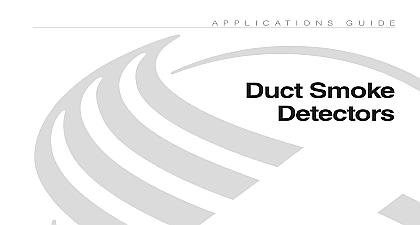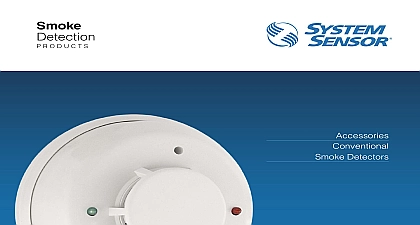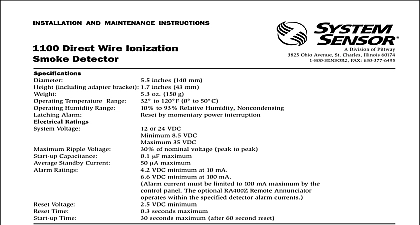System Sensor Beam Smoke Detectors

File Preview
Click below to download for free
Click below to download for free
File Data
| Name | system-sensor-beam-smoke-detectors-9210483675.pdf |
|---|---|
| Type | |
| Size | 1.07 MB |
| Downloads |
Text Preview
A P P L I C A T I O N S G U I D E Beam Detector Reflected Smoke Detector 1 Principles of Operation 2 Applications 4 2 3 Design Considerations 5 2 Beam Smoke Detectors vs Spot Type Smoke Detectors 2 5 2 and Spacing 5 Height 2 Considerations for Reflected Beam Smoke Detectors 5 Air Velocity 3 Mounting Considerations for Reflected Beam Smoke Detectors 6 3 A Glossary of Terms 7 Release Rate 4 B NFPA 92 Reference 7 smoke detectors can be important components of a well designed automatic fire alarm system Because of their capabilities beam detectors overcome some of the limitations of spot type smoke detectors This guide was developed to help the fire alarm designer gain an understanding the beam smoke detector capabilities and when they may be the preferred technology for a particular application guide provides information on the proper utilization of beam smoke detectors in life safety and property protection applications In addition it sum the operating principles of single ended reflected beam smoke detectors their design requirements and their practical applications as a of an automatic fire alarm system beam smoke detectors are not suited for all applications they may be the detector of choice in many applications where spot type detec are not practical equipment from different manufacturers has varying specifications and listings the information in this guide is general in nature and should be substituted for the manufacturer recommendations or code requirements GUIDE SINLGE ENDED REFLECTED BEAM SMOKE DETECTORfirealarmresources com 1 of Operation beam smoke detectors consist of a transceiver a transmitter unit that projects monitors and receives a beam reflected across protected area detector works on the principle of light obscuration The photosensitive sees light produced by the transceiver unit in a normal condition transceiver unit is calibrated to a preset sensitivity level based on a of total obscuration This sensitivity level is determined by the based on the length of the beam the distance between the unit and reflector For UL listed detectors the sensitivity setting comply with UL Standard 268 Smoke Detectors for Fire Protective Systems line of sight Unit 1 smoke detectors operate on the principle of obscuration As a smoke develops the detector senses the cumulative obscuration the per of light blockage created by a combination of smoke density and linear distance of the smoke field across the projected light beam The is typically set by the manufacturer to match the conditions of installation the appropriate sensitivity minimizes the possibility of nuisance that would result from a blockage of the beam by a solid object inadvertently in its path Since the sudden and total obscuration of light beam is not a typical smoke signature the detector will see this a trouble condition not an alarm addition very small slow changes in the quality of the light source are typical of a smoke signature These changes may occur because of conditions such as dust and dirt accumulation on the trans unit optical assemblies or on the reflective surface the detector is first turned on and put through its setup program it the light signal level at that time as a reference point for a nor condition As the quality of the light signal degrades over time the Gain Control AGC compensates for the change The rate of however is limited to ensure that the detector will still be to slow building or smoldering fires When the AGC can no lon compensate for the loss of the signal perhaps due to an excessive of dust or dirt the detector will signal a trouble condition to the beam smoke detector may include remote annuncia as well as remote test stations which allow for the periodic electronic sensitivity testing of the detector Intelligent fire alarm systems can the beam smoke detector a discrete address to provide better annun of the fire location accessories that can be used with reflected beam smoke detec include surface mount kits multi mount kits and long range kits kits allow reflected beam detectors to be mounted when wiring is used Multi mount kits allow reflected beam detectors and to be mounted to either the wall or ceiling The surface mount kit be used when installing the multi mount kit to the detector Long range allow the reflected beam detector to be installed at longer distances the reflector typically 230 to 328 feet or 70 to 100 meters allow the optical surface of the beam detector and reflector to a slightly higher temperature than the surrounding air This helps minimize condensation in environments that experience temperature 2 Smoke Detectors vs Smoke Detectors detectors are governed by UL and NFPA 72 2013 Section It is important that designers understand and give full consid to these requirements when selecting and applying beam smoke to fire alarm systems smoke detectors can cover an area which would require a dozen more spot type detectors Fewer devices mean lower installation and costs smoke detectors generally have a maximum range of 330 feet and maximum spacing between detectors of 60 feet This gives the beam detector theoretical coverage of 19,800 square feet Manufacturer and other factors such as room geometry may impose reductions of this maximum coverage smoke detectors are considered to have a maximum cover of 900 square feet The maximum length between detectors is 41 feet the width of the area being protected does not exceed 10 feet as a hallway Height spot type smoke detector response time generally increases its distance from the fire floor increases this is not necessarily the case beam smoke detectors which are ideally suited for high ceiling appli Some manufacturers however may require additional detectors ceiling height increases This is because of the anticipated behavior of plume of smoke usually start at or near floor level When that occurs the smoke rises to or near the ceiling Typically the column of smoke begins to spread as it travels from its point of origin forming a smoke field in the shape an inverted cone density of the smoke field can be affected by the rate of growth of the Fast fires tend to produce more uniform density than slow burning where there may be dilution at the upper elevations of the smoke field some applications especially where high ceilings are present beam detectors may be more responsive to slow or smoldering fires than detectors because they are looking across the entire smoke field the beam Spot type detectors only sample smoke at their par The smoke which enters the chamber may be diluted below level of smoke needed to activate an alarm SENSORfirealarmresources com limitation of beam smoke detectors is that as line of sight devices they subject to interference from any object or person which enters the path As a result their use is impractical in most occupied areas normal ceiling heights smoke detectors however are often the detectors of choice in facil with high ceilings such as atria lobbies gymnasiums sports arenas plane hangars and church sanctuaries as well as factories warehouses Many of these applications present sp


